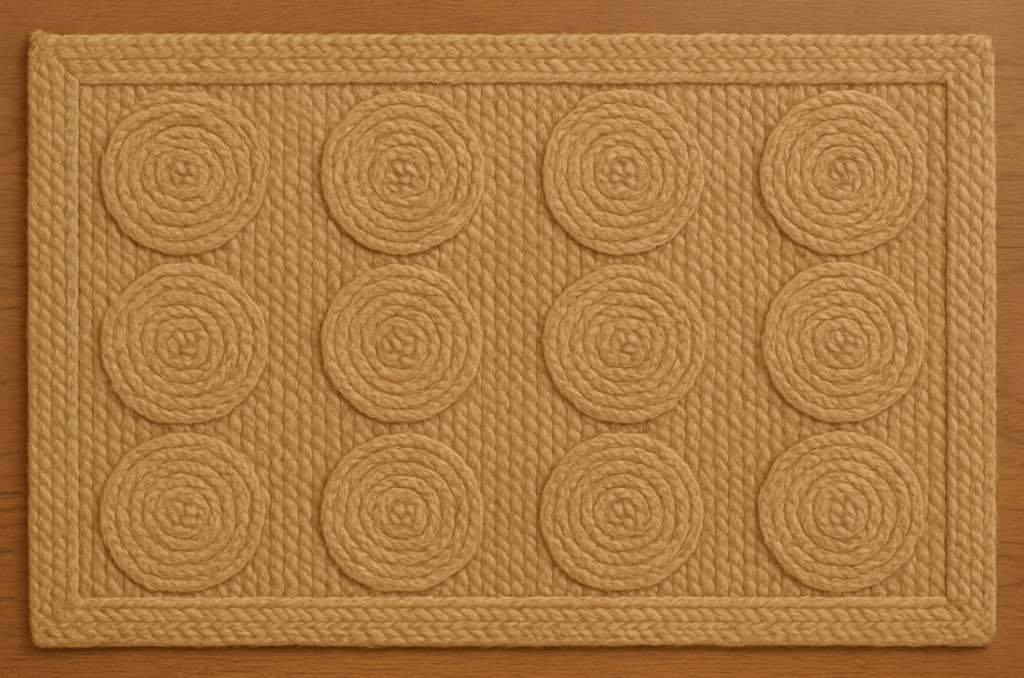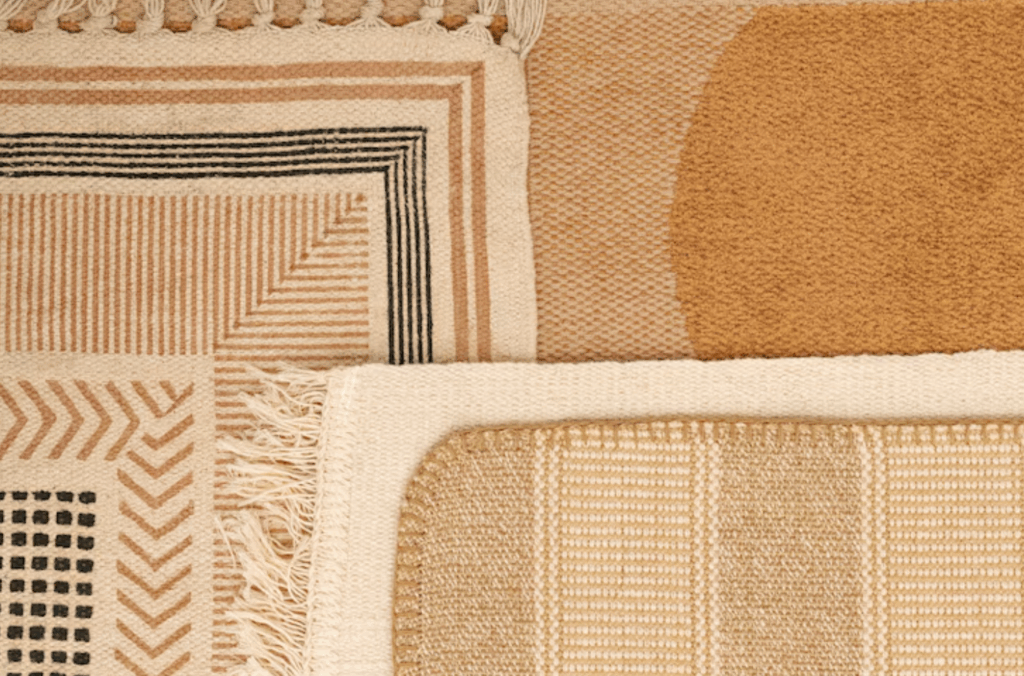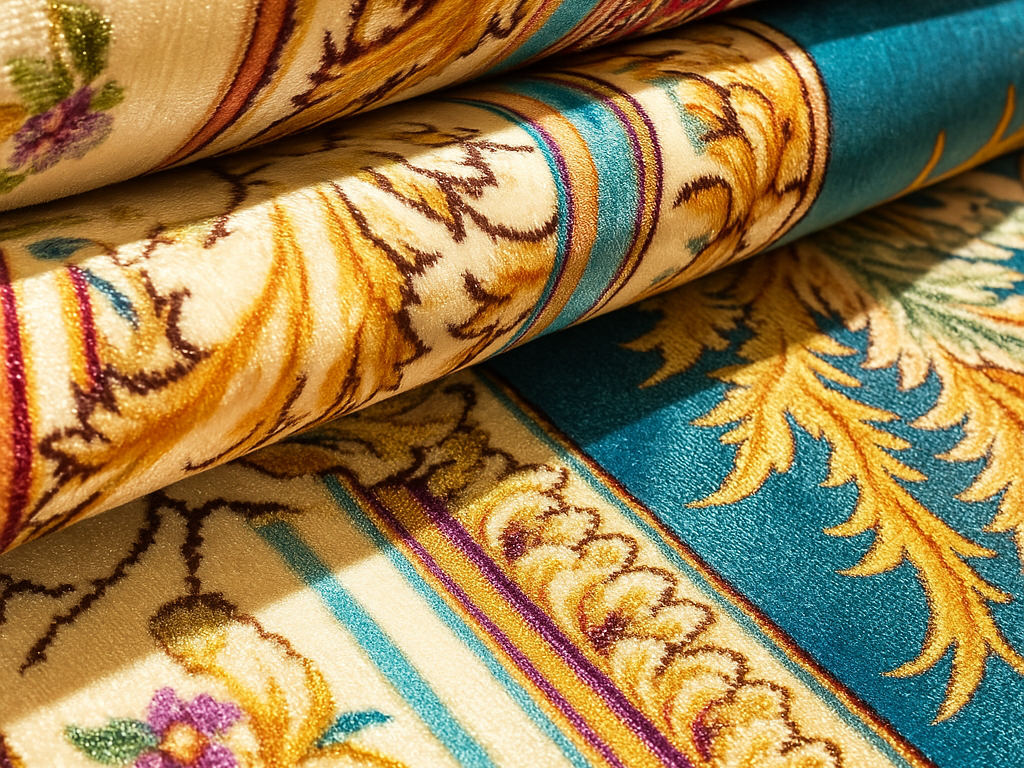집에 어울리는 러그를 고를 때 울 러그는 오랫동안 많은 사람이 선호하는 선택지였습니다. 고급스러운 느낌과 내구성, 유행을 타지 않는 아름다움으로 유명한 울 러그는 전통 인테리어와 현대 인테리어 모두에서 필수품입니다. 하지만 모든 제품과 마찬가지로 양모 러그에도 장단점이 있습니다.

이 글에서는 양모 러그의 장단점을 살펴보고 정보에 입각한 결정을 내리는 데 도움을 드리고자 합니다.
1. 양모 러그의 장점
양모 러그 는 편안함과 스타일 모두에서 최고의 옵션 중 하나로 꼽힙니다. 이미 몇 가지 주요 장점에 대해 언급했지만, 양모 러그는 다양한 가정 환경에 탁월한 선택이 될 수 있는 다양한 추가 장점이 있습니다. 울 러그의 다양한 장점에 대해 자세히 알아보세요.
내구성 및 수명
양모는 마모와 찢어짐에 매우 강한 내구성이 뛰어난 소재입니다. 울은 자연적으로 강하기 때문에 발자국 소리를 견뎌야 하는 러그에 이상적인 섬유입니다. 울의 복원력은 자연스러운 주름과 탄력 있는 질감에서 비롯됩니다. 양모의 섬유는 압축된 후 회복되는 독특한 구조를 가지고 있어 통행량이 많은 지역에서도 러그의 푹신한 모양과 느낌을 수년 동안 유지할 수 있습니다.
부드러움과 편안함
울은 자연적으로 부드럽고 탄력이 있어 발밑에서 고급스러운 느낌을 줍니다. 양말을 신고 걷든, 맨발로 걷든, 심지어 누워 있든 울의 부드러움은 타의 추종을 불허하는 편안함을 선사합니다. 섬유가 자연스럽게 감겨 있어 푹신한 질감이 특징이며, 발과 관절에 가해지는 부담을 줄여주는 쿠션감을 제공합니다. 따라서 울 러그는 거실, 침실, 독서실 등 사람들이 주로 앉거나 누워 있는 공간에 특히 이상적입니다.
얼룩 방지
양모의 뛰어난 특성 중 하나는 자연스러운 얼룩 방지. 양모 섬유에는 먼지와 습기에 대한 천연 발수제 역할을 하는 왁스 같은 물질인 라놀린이 함유되어 있습니다. 라놀린 코팅은 액체, 기름, 먼지가 섬유에 침투하기 어렵게 만들어 흘린 것을 더 쉽게 청소할 수 있고 얼룩이 생기는 것을 방지합니다.
또한 양모는 섬유의 수분 흡수 특성으로 인해 오염에 대한 저항력이 더욱 향상됩니다. 다른 소재와 달리 합성 섬유수분을 가둘 수 있는 양모는 표면에서 섬유 속으로 수분을 빠르게 끌어당겨 증발시킵니다. 따라서 울 러그는 먼지와 때가 잘 쌓이지 않아 자주 청소할 필요가 줄어듭니다.
양모 러그는 합성 섬유나 다른 천연 섬유 러그에 비해 시간이 지나도 깨끗하게 유지될 가능성이 높기 때문에 어린이나 반려동물이 있거나 발이 많이 다니는 가정에 적합한 옵션입니다.
통기성
양모는 수분과 온도를 조절하는 자연적인 능력으로 인해 통기성이 뛰어납니다. 이러한 통기성은 울 러그가 습기나 습기가 쌓이는 것을 방지하여 실내의 균형 잡힌 분위기를 유지하는 데 도움이 된다는 것을 의미합니다. 더운 날씨에는 양모가 공기 중의 수분을 흡수하여 실내를 건조하고 시원하게 유지하는 데 도움이 됩니다.
반대로 양모는 천연 단열재이기도 합니다. 양모는 따뜻한 공기를 섬유 안에 가두어 추운 계절에 실내 온도를 조절하는 데 도움이 됩니다. 이 단열재는 난방 시스템에만 의존하지 않고도 겨울철에 공간을 더 따뜻하게 만들 수 있습니다. 울 러그는 온도와 습기를 조절하여 일 년 내내 쾌적하고 통기성이 좋은 분위기를 조성합니다.
알레르기나 호흡기 질환을 앓고 있는 분들에게도 양모의 공기 정화 기능이 도움이 될 수 있습니다. 양모 섬유는 먼지와 알레르겐을 자연적으로 흡수하여 공기 중에 떠다니는 것을 방지합니다. 이는 더 깨끗하고 건강한 실내 환경을 조성하는 데 기여합니다.
자연 단열
울의 단열 특성은 온도 조절을 넘어서는 다양한 기능을 제공합니다. 울은 천연 흡음재이기 때문에 시끄러운 집이나 아파트의 소음을 줄이는 데 탁월한 선택입니다. 울 섬유는 소리를 흡수하는 능력이 있어 다음과 같이 넓고 개방된 공간이나 교통량이 많은 공간에서 반향을 최소화하는 데 도움이 될 수 있습니다. 복도 그리고 거실.
친환경
양모는 재생 가능한 자원입니다. 양은 매년 새로운 양털을 자라기 때문에 양모는 본질적으로 지속 가능한 소재입니다. 석유와 같은 재생 불가능한 자원에서 추출되는 합성 섬유에 비해 울의 생산 공정은 환경에 미치는 영향이 훨씬 적습니다. 러그용 양모를 생산하는 과정에는 최소한의 에너지만 사용되며, 양모는 자연적으로 생분해되므로 합성 러그처럼 수세기 동안 쓰레기 매립지에 쌓이지 않습니다.
2. 양모 러그의 단점
울 러그는 다양한 장점을 제공하지만, 그에 따른 문제점도 있습니다. 잠재적인 단점을 이해하면 정보에 입각한 결정을 내리고 울 러그가 자신의 라이프스타일과 집에 적합한지 확인하는 데 도움이 될 수 있습니다. 양모 러그의 단점에 대해 자세히 알아보세요.

비용
울 러그의 가장 큰 단점 중 하나는 비용입니다. 양모는 천연 고품질 섬유로 생산에 노동 집약적인 공정이 필요하기 때문에 합성 섬유에 비해 가격이 높습니다. 양모 러그의 가격은 양모의 품질과 같은 요인에 따라 크게 달라질 수 있습니다, 러그의 크기수공예품이든 기계로 만든 제품이든 상관없습니다.
예산에 민감한 구매자에게는 울 러그의 높은 초기 비용이 큰 걸림돌이 될 수 있습니다. 양모의 내구성과 수명은 장기적으로 볼 때 투자를 정당화할 수 있지만, 초기 가격이 부담스러운 분들도 있을 수 있습니다. 또한 집안의 여러 방이나 공간에 사용할 러그를 여러 개 구입하는 경우 전체 비용이 빠르게 늘어날 수 있습니다.
유지 관리
양모 러그는 합성 러그보다 더 높은 수준의 관리와 유지 관리가 필요합니다. 양모의 자연적인 얼룩 방지 기능은 큰 장점이지만, 러그의 외관과 내구성을 유지하려면 정기적인 청소와 유지 관리가 필요합니다. 다음은 고려해야 할 몇 가지 유지 관리 요소입니다:
- 정기적인 진공 청소기 청소: 양모 섬유는 먼지, 오물, 반려동물의 털을 가둘 수 있어 제대로 청소하지 않으면 시간이 지남에 따라 마모가 발생할 수 있습니다. 울 러그에 이물질이 없도록 정기적으로 진공청소기로 청소하는 것이 좋습니다. 섬유가 손상되지 않도록 부드러운 설정의 진공청소기나 흡입 전용 부착물을 사용하세요.
- 딥 클리닝: 양모는 얼룩에 강하지만 시간이 지남에 따라 먼지가 쌓이기 쉽습니다. 가벼운 얼룩은 스팟 클리닝으로 해결할 수 있지만, 울 러그의 부드러움과 외관을 유지하려면 1~2년마다 전문적으로 청소해야 합니다. 전문 청소는 일반 진공청소기로는 놓칠 수 있는 먼지를 제거하고 집먼지 진드기나 알레르기 유발 물질의 축적을 방지하는 데 도움이 될 수 있습니다.
- 독한 화학 물질을 피하세요: 양모 러그는 합성 러그보다 더 섬세하기 때문에 강한 화학 세제나 연마성 브러시를 사용하면 섬유가 손상될 수 있습니다. 양모 전용 청소 제품을 사용하고 러그의 천연 오일을 제거하거나 변색을 유발할 수 있는 청소 방법을 피하는 것이 중요합니다.
양모 러그에 필요한 추가적인 관리와 주의는 관리가 간편하고 번거롭지 않은 옵션을 찾는 사람들에게는 적합하지 않을 수 있습니다. 최소한의 유지 관리를 선호하는 사람이라면 합성 소재나 기타 내구성이 뛰어난 러그 소재가 더 적합할 수 있습니다.
나방에 대한 취약성
양모 러그는 특히 제대로 관리하지 않으면 나방 및 기타 벌레에 취약할 수 있습니다. 나방은 양모의 단백질이 풍부한 섬유에 끌리기 때문에 방치하면 러그를 갉아먹어 심각한 피해를 입힐 수 있습니다. 나방은 이러한 조건에서 번성하는 경향이 있으므로 따뜻한 기후나 습도가 높은 지역에서는 특히 문제가 될 수 있습니다.
나방 피해는 적절한 관리로 예방할 수 있지만, 부지런함이 필요합니다. 양모 러그를 나방으로부터 보호하는 몇 가지 방법을 소개합니다:
- 정기 청소: 진공청소기를 자주 사용하면 러그에 나방 유충이 생기는 것을 방지할 수 있습니다. 먼지, 오물, 음식물 찌꺼기가 쌓일 수 있는 부분은 나방을 유인할 수 있으므로 특히 주의하세요.
- 저장소: 양모 러그를 장기간 보관할 때는 깨끗이 세척한 후 돌돌 말아서 건조하고 서늘한 곳에 보관하세요. 삼나무나 라벤더 같은 천연 나방 퇴치제를 사용하면 섬유를 손상시키지 않으면서도 나방을 퇴치할 수 있습니다.
- 나방 치료: 일부 양모 러그는 나방 방지 처리를 하기도 하지만 비용이 추가될 수 있습니다. 러그에 작은 구멍이나 줄무늬 등 나방 피해의 징후가 있는지 주기적으로 검사하여 즉각적인 조치를 취하는 것이 중요합니다.
나방이 자주 발생하는 지역의 집주인이라면 양모 러그를 선택할 때 나방 피해의 위험성을 고려해야 합니다. 나방 피해는 예방할 수 있지만 주의와 정기적인 관리가 필요합니다.
셰딩
울 러그의 또 다른 단점은 특히 새 제품일 때 털이 빠지는 것입니다. 양모 섬유는 사용 초기에는 러그에서 느슨한 섬유가 풀리면서 자연적으로 털이 빠집니다. 이는 정상이며 시간이 지남에 따라 감소하는 경향이 있지만 초기에는 성가신 일이 될 수 있습니다. 양모 러그는 합성 러그보다 털이 더 많이 빠지기 때문에 집안에 먼지와 섬유가 쌓일 수 있습니다.
털 빠짐은 느슨한 섬유가 실내 공기 오염의 원인이 될 수 있으므로 알레르기나 천식이 있는 사람에게는 특히 문제가 될 수 있습니다. 정기적으로 진공청소기를 사용하면 털 빠짐을 관리하는 데 도움이 될 수 있지만, 털 빠짐이 현저히 줄어들려면 몇 달이 걸릴 수 있다는 점에 유의하세요. 어떤 사람들은 양모 러그의 섬유를 지속적으로 청소하는 것이 번거로울 수 있습니다.
털이 빠지는 것이 걱정된다면 시간이 지나면서 털이 덜 빠지는 고품질 양모 러그나 촘촘하게 짜여진 디자인을 선택하는 것이 좋습니다. 또한 털 빠짐이 처음에는 문제가 될 수 있지만 일반적으로 장기적으로 러그의 내구성이나 성능에는 영향을 미치지 않는다는 점도 주목할 필요가 있습니다.
습한 환경에는 적합하지 않음
양모는 흡수성이 뛰어나 환경에 따라 장점이자 단점이 될 수 있습니다. 양모는 습기를 흡수하는 특성으로 인해 건조한 공간의 온도와 습도를 조절하는 데 적합하지만 욕실, 주방, 지하실 등 습기에 많이 노출되는 공간에는 적합하지 않습니다. 양모 러그가 젖어 습기가 있는 상태로 장시간 방치되면 곰팡이 및 곰팡이의 번식지가 될 수 있습니다.
3. 결론
울 러그는 내구성, 편안함, 지속 가능성 면에서 탁월한 조합을 자랑하기 때문에 많은 집주인이 선호하는 제품입니다. 천연 섬유는 단열성, 부드러움, 얼룩 방지 기능을 제공하기 때문에 통행량이 많은 공간과 아늑한 공간 모두에 탁월한 선택이 될 수 있습니다. 하지만 양모 러그에는 높은 비용과 정기적인 관리가 필요하다는 단점이 있습니다. 또한 나방과 털 빠짐에 취약하며 습기가 많은 환경에는 적합하지 않을 수 있습니다.
궁극적으로 울 러그를 선택하는 것은 개인의 취향, 라이프스타일, 예산에 따라 결정됩니다. 수년간 사용할 수 있는 고품질 러그에 투자할 의향이 있고 적절한 관리가 가능하다면 양모 러그는 집에 멋진 인테리어 소품이 될 수 있습니다.
4. 자주 묻는 질문
1. 양모 러그는 투자할 만한 가치가 있나요?
예, 울 러그는 일반적으로 내구성, 편안함, 긴 수명으로 인해 투자할 만한 가치가 있습니다. 초기 비용은 더 비싸지만 수십 년 동안 사용할 수 있어 장기적인 가치를 제공합니다.
2. 양모 러그는 털이 많이 빠지나요?
양모 러그는 새것일 때는 털이 빠질 수 있지만 일반적으로 시간이 지남에 따라 털이 빠지는 양이 줄어듭니다. 정기적으로 진공청소기로 청소하면 이 문제를 관리하는 데 도움이 될 수 있습니다.
3. 양모 러그는 쉽게 청소할 수 있나요?
양모 러그는 비교적 쉽게 청소할 수 있습니다. 정기적으로 진공청소기로 청소하고 주기적으로 전문 청소를 하면 외관을 유지하는 데 도움이 될 수 있습니다. 하지만 합성 러그보다 더 많은 관리가 필요합니다.
4. 양모 러그는 반려동물이 있는 집에 좋은가요?
양모 러그는 자연적으로 얼룩이 잘 생기지 않고 내구성이 뛰어나 반려동물이 있는 가정에 적합한 제품입니다. 하지만 반려동물의 털과 먼지를 제거하려면 정기적으로 진공청소기로 청소하는 것이 필수적입니다.
5. 욕실에 양모 러그를 사용해도 되나요?
양모는 습기를 흡수하는 특성 때문에 욕실에 적합하지 않습니다. 욕실용 러그를 찾고 있다면 습기에 더 강한 합성 소재를 고려하세요.


